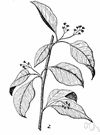black gum
(redirected from Blackgum)black gum
or black·gum (blăk′gŭm′)n.
A deciduous tree (Nyssa sylvatica) of eastern North America, having glossy, somewhat leathery leaves that turn bright scarlet or orange in the fall. Also called pepperidge, sour gum.
American Heritage® Dictionary of the English Language, Fifth Edition. Copyright © 2016 by Houghton Mifflin Harcourt Publishing Company. Published by Houghton Mifflin Harcourt Publishing Company. All rights reserved.
sour′ gum`
n.
a tupelo, Nyssa sylvatica, of E North America, with egg-shaped leaves and round, dark blue fruit.
Also called black gum, pepperidge. [1775–85, Amer.]
Random House Kernerman Webster's College Dictionary, © 2010 K Dictionaries Ltd. Copyright 2005, 1997, 1991 by Random House, Inc. All rights reserved.
ThesaurusAntonymsRelated WordsSynonymsLegend:
| Noun | 1. |  black gum - columnar tree of eastern North America having horizontal limbs and small leaves that emerge late in spring and have brilliant color in early fall black gum - columnar tree of eastern North America having horizontal limbs and small leaves that emerge late in spring and have brilliant color in early falltupelo tree, tupelo - any of several gum trees of swampy areas of North America |
| 2. | black gum - a small mallee with rough dark-colored bark toward the butt; yields a red eucalyptus kino gum mallee - any of several low-growing Australian eucalypts |
Based on WordNet 3.0, Farlex clipart collection. © 2003-2012 Princeton University, Farlex Inc.